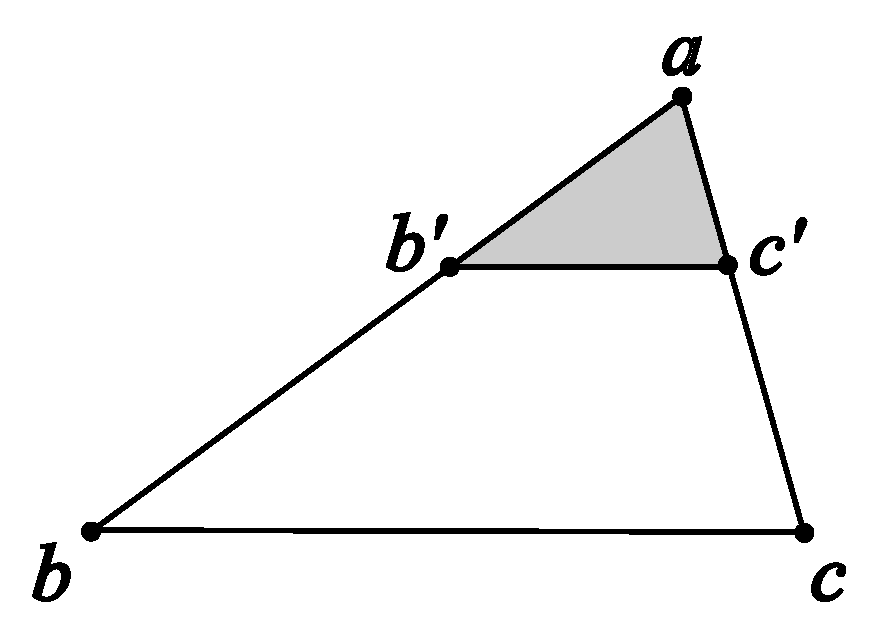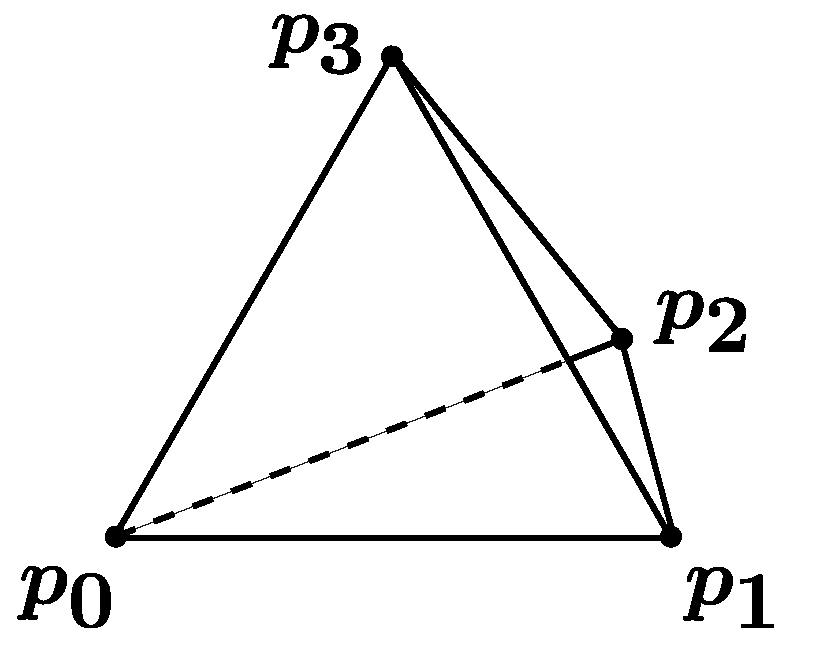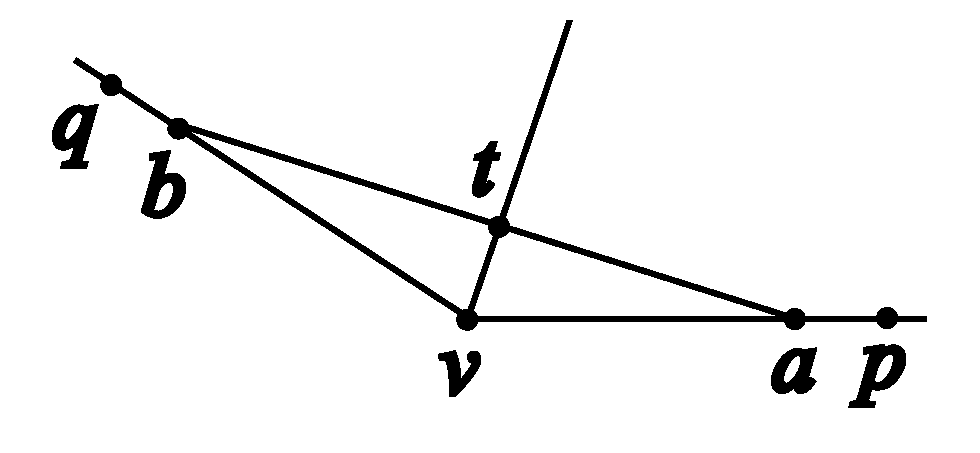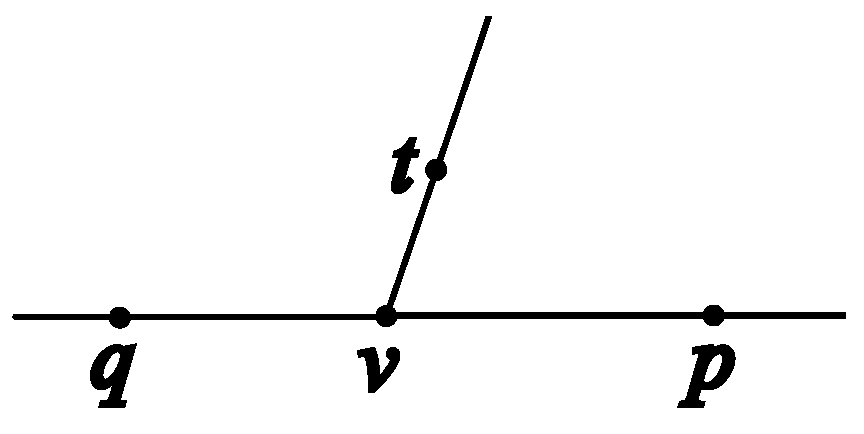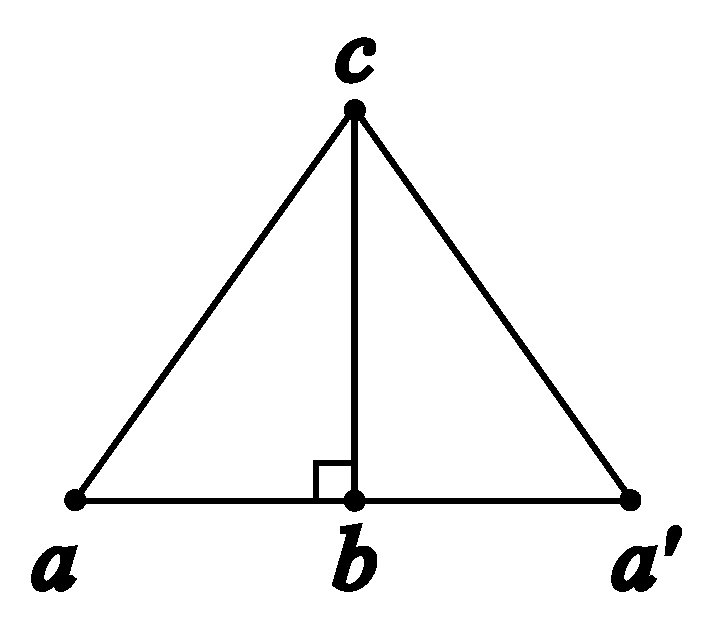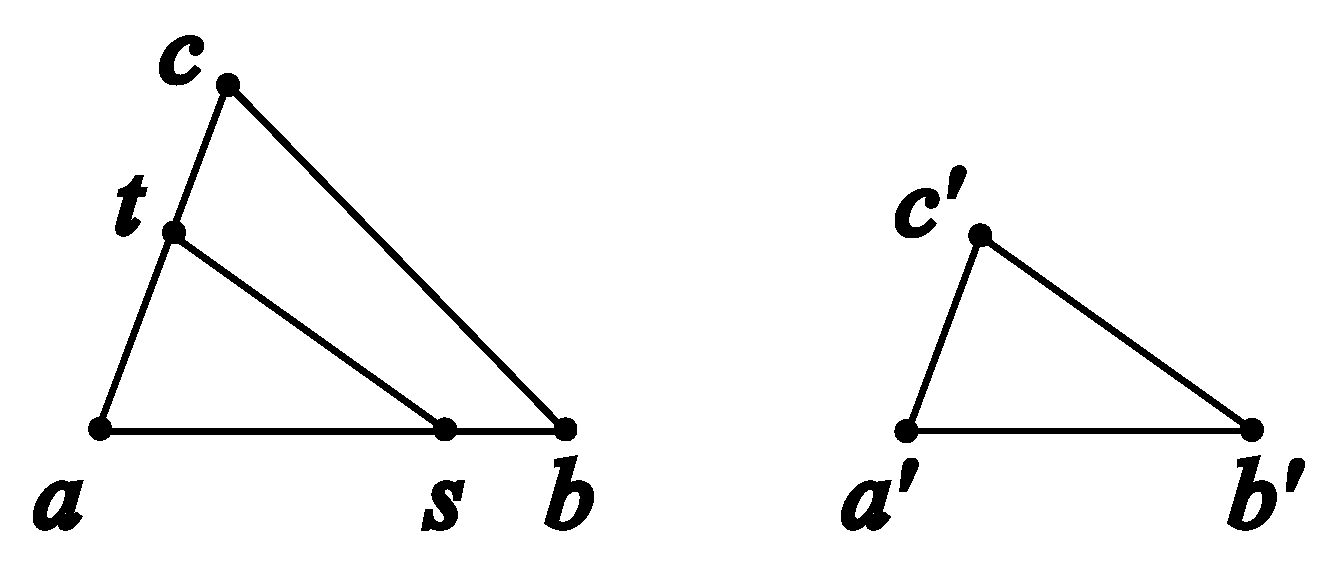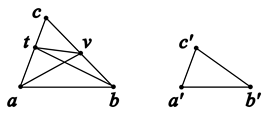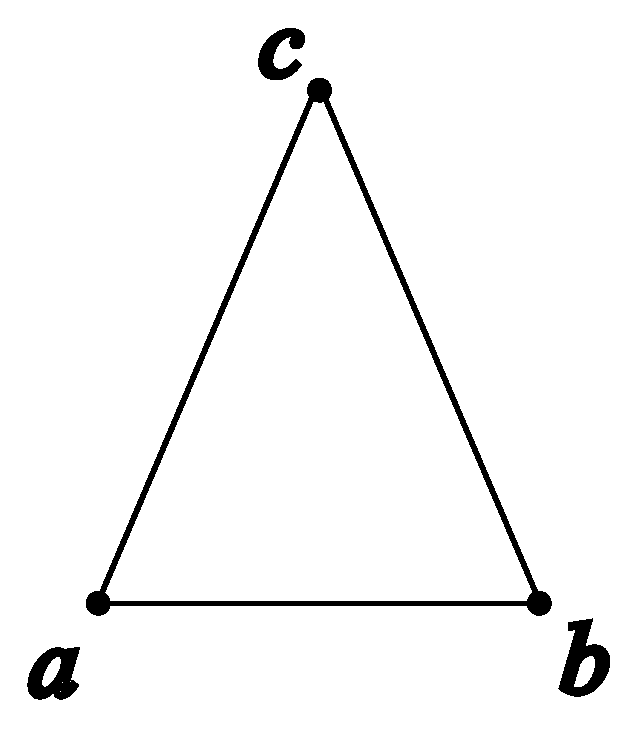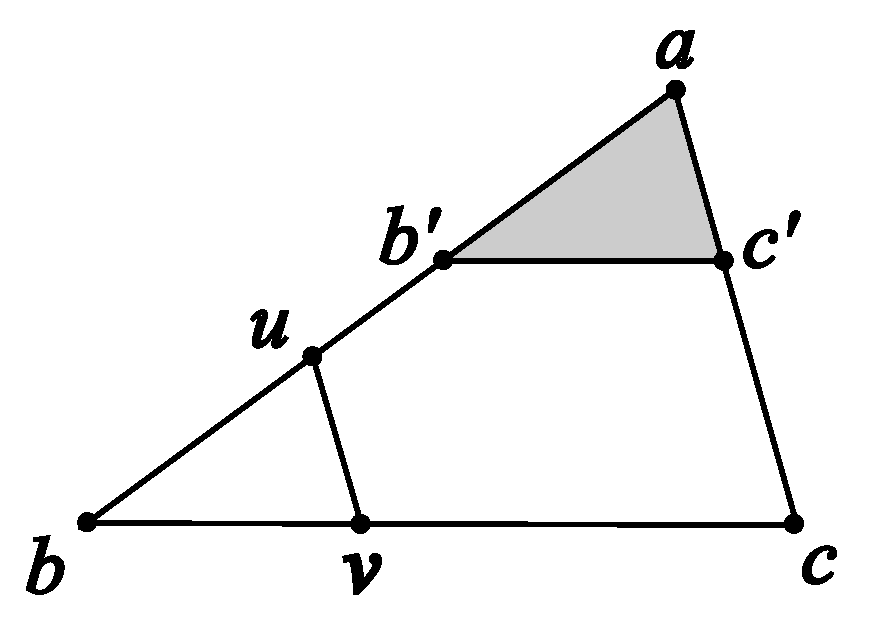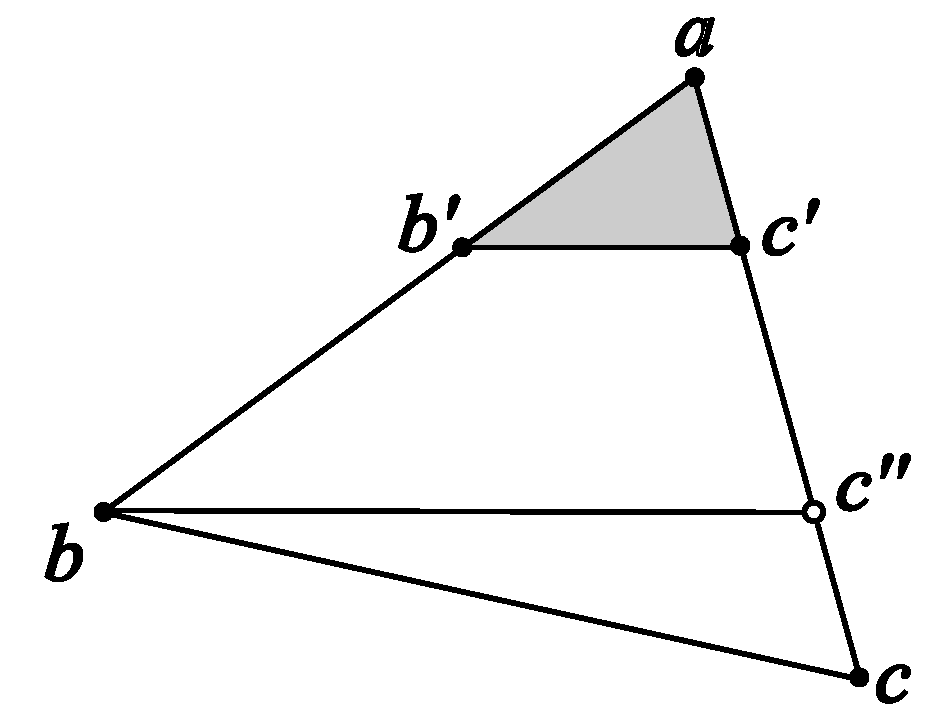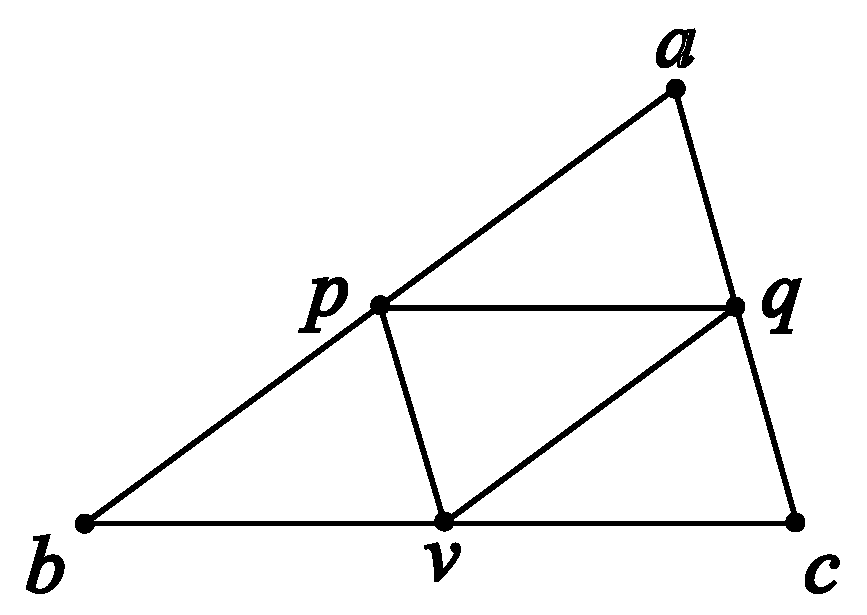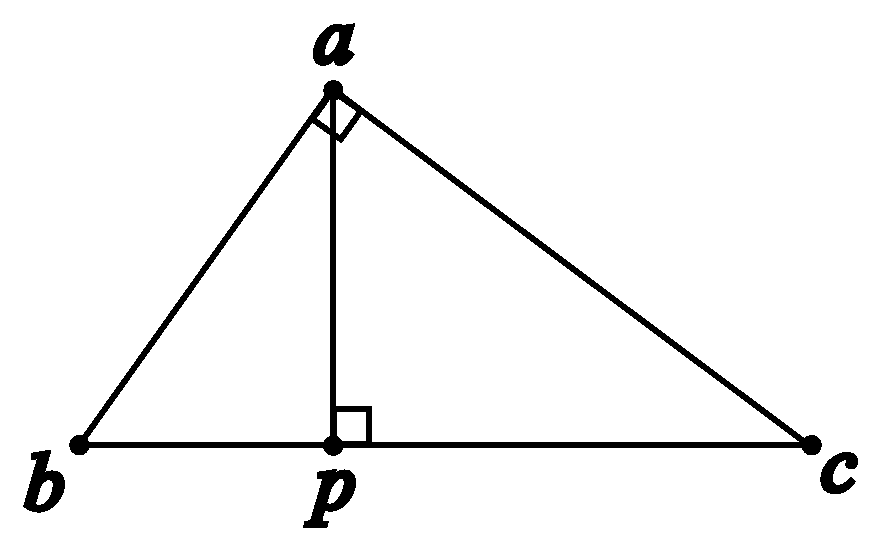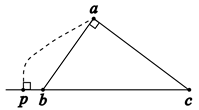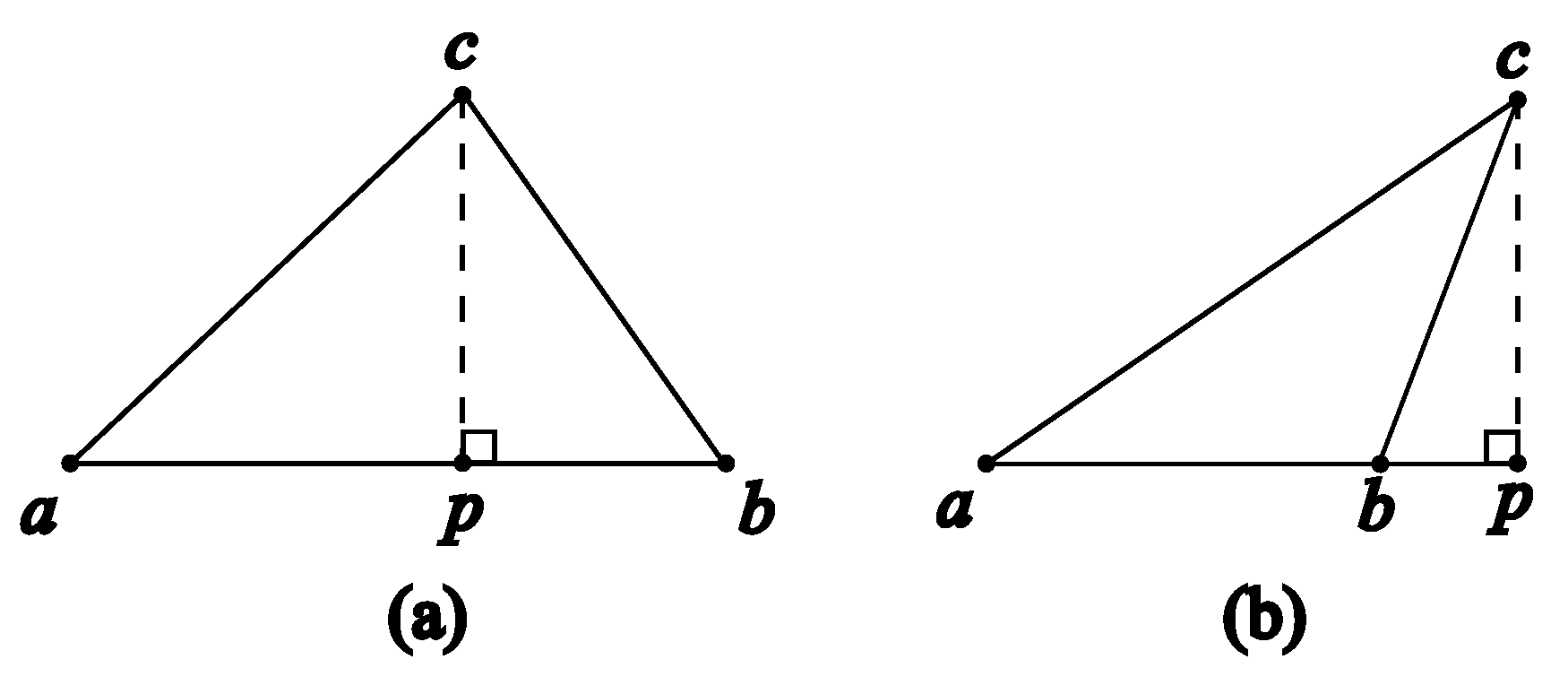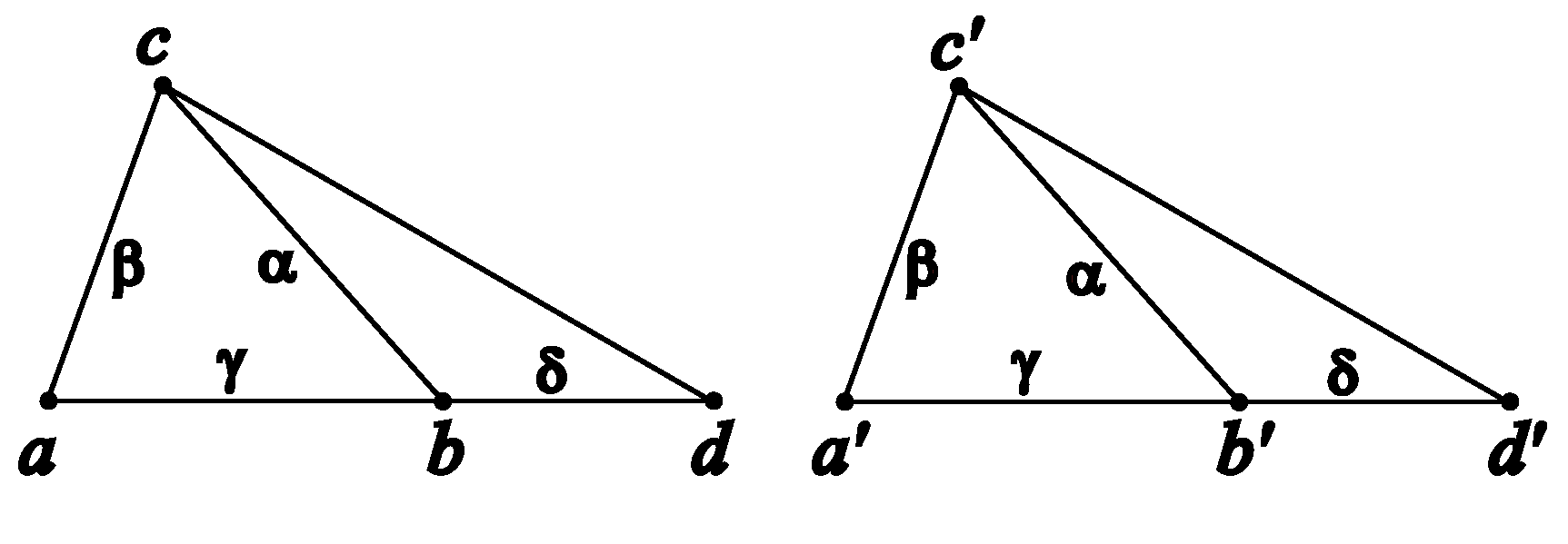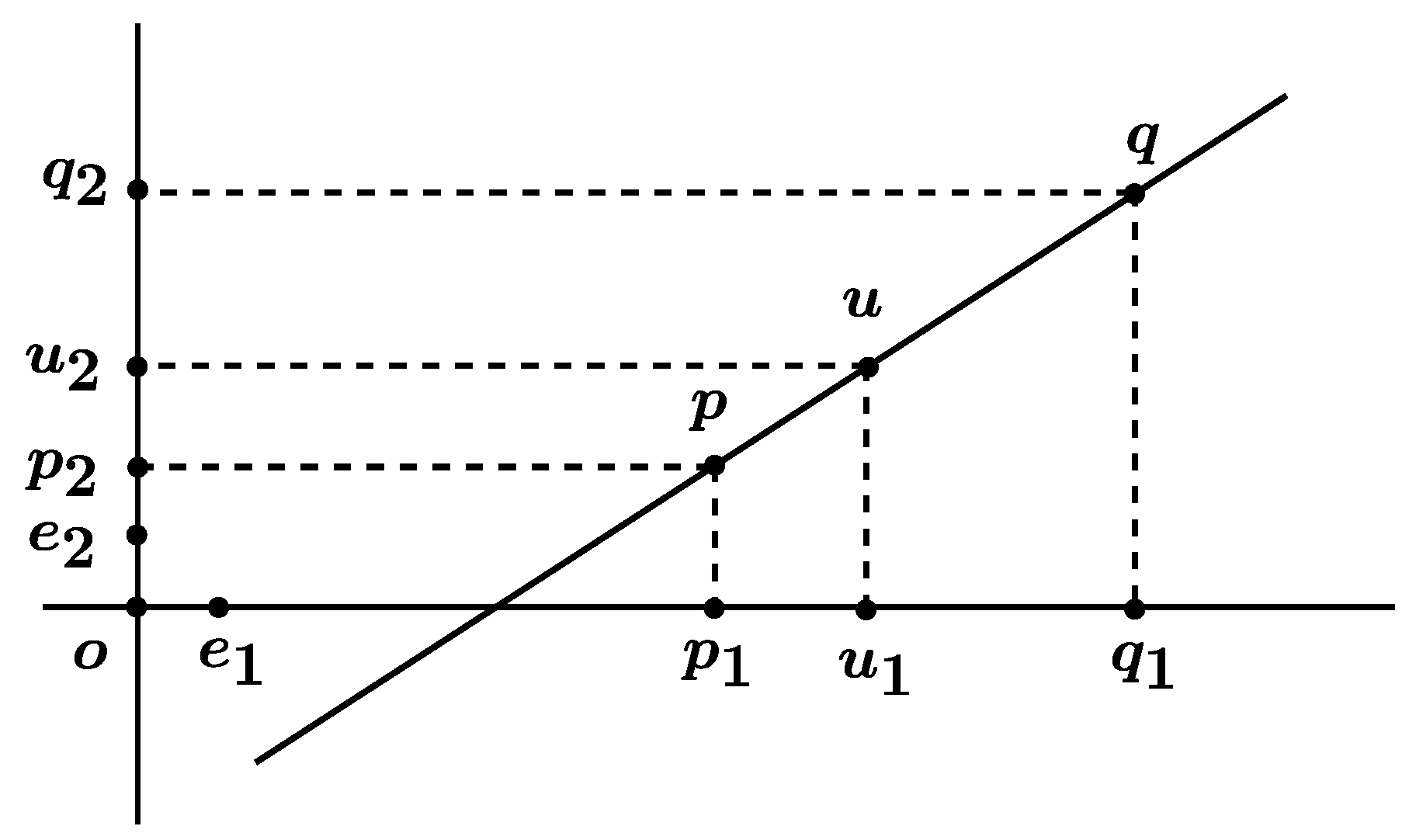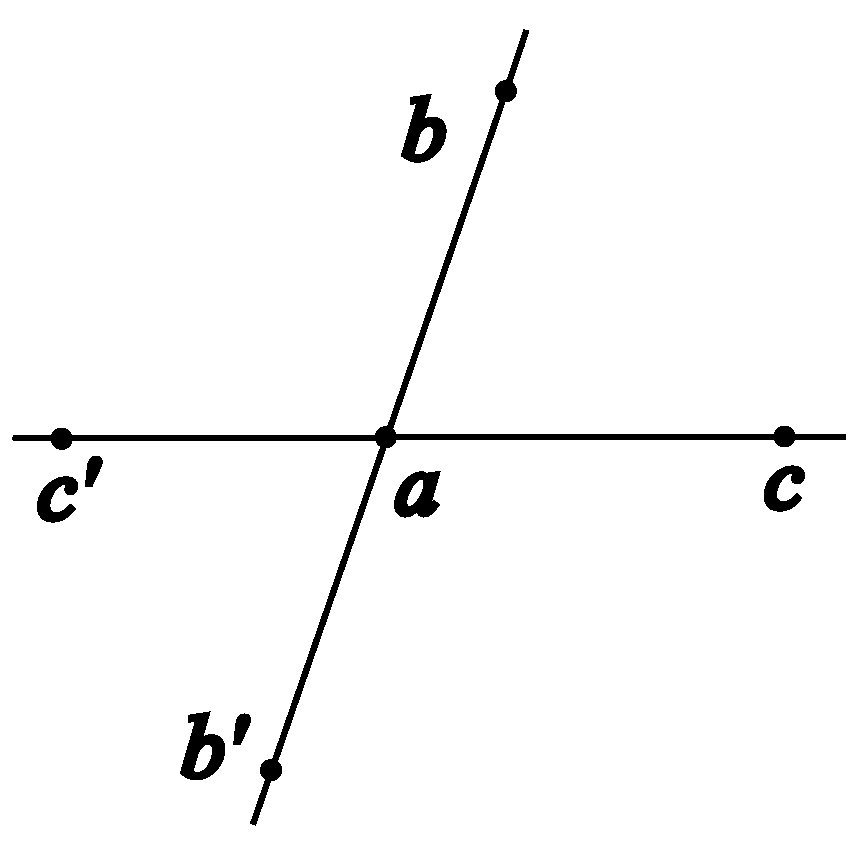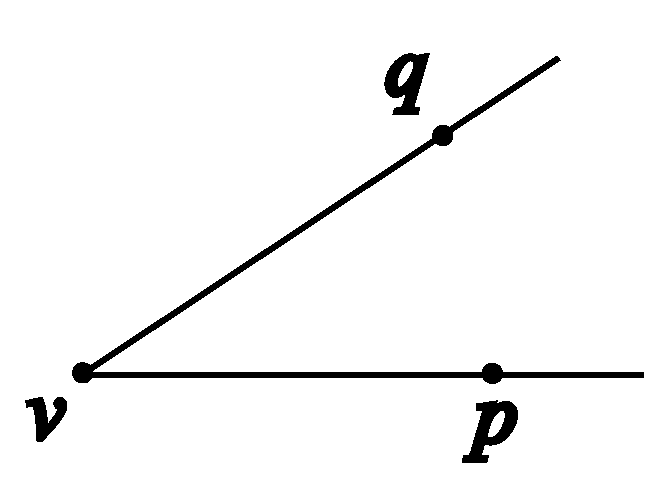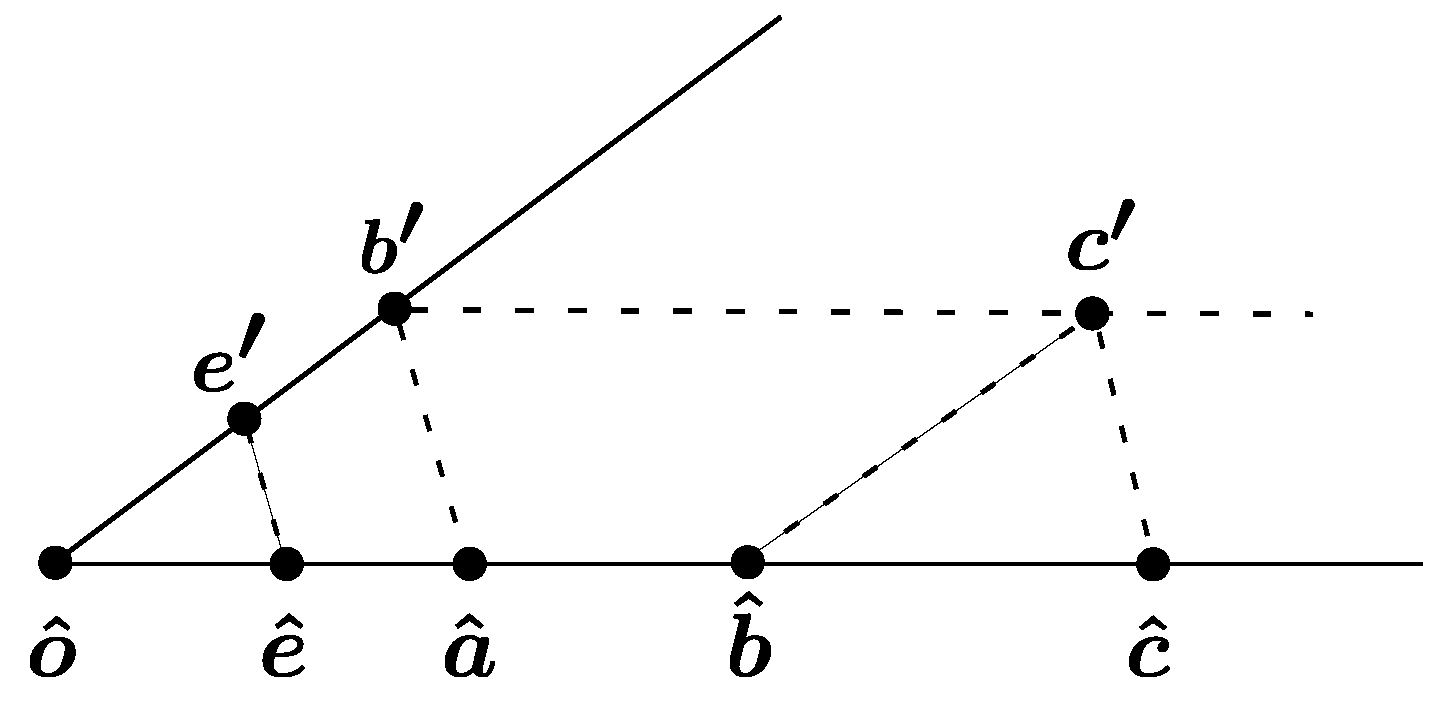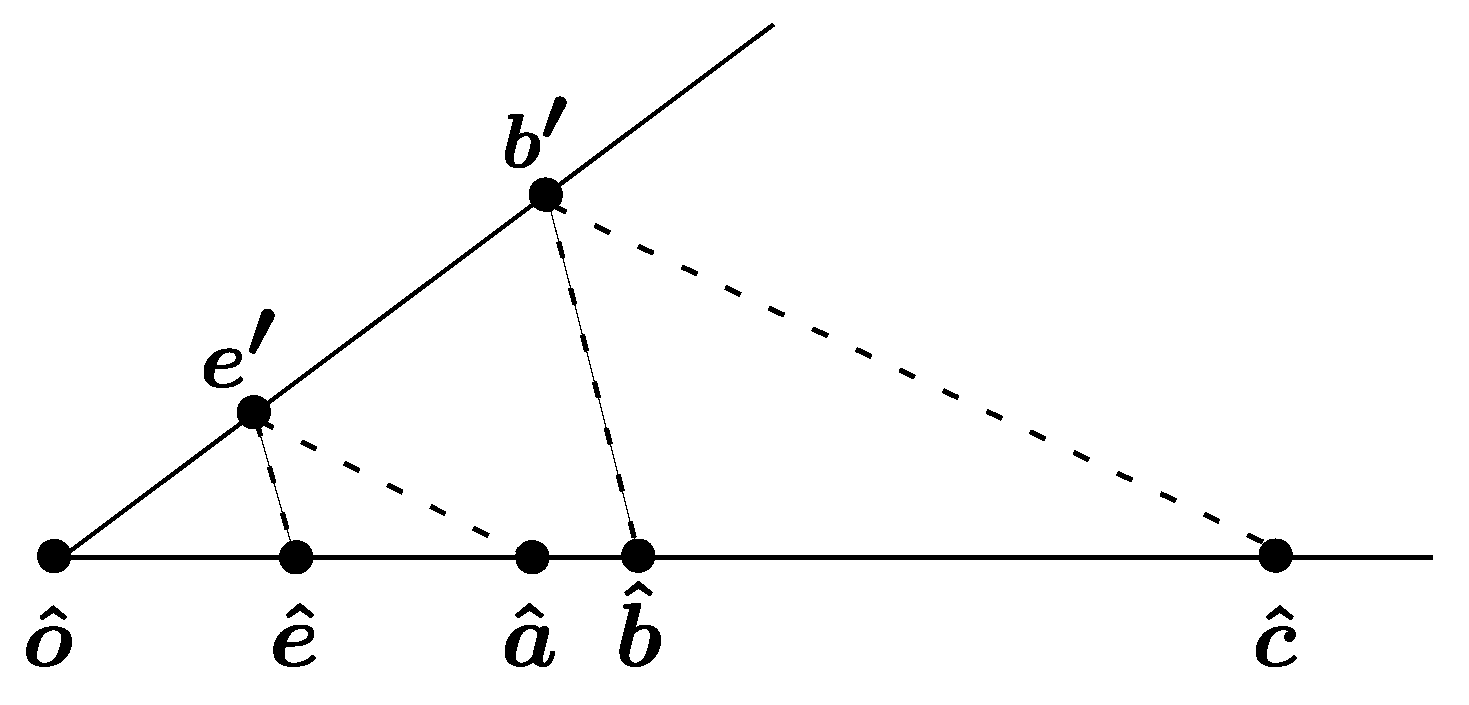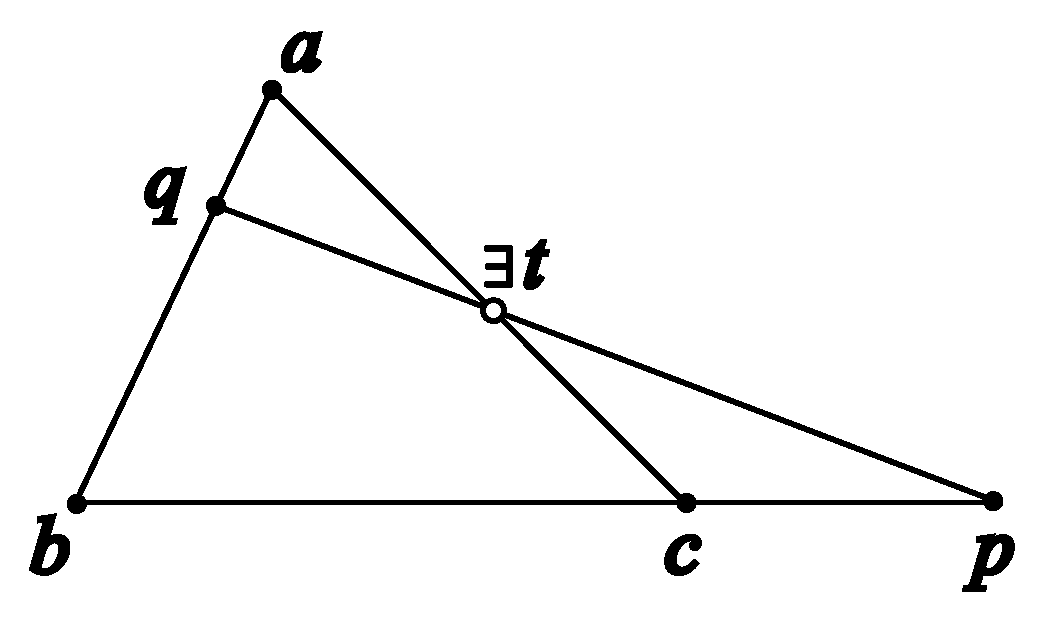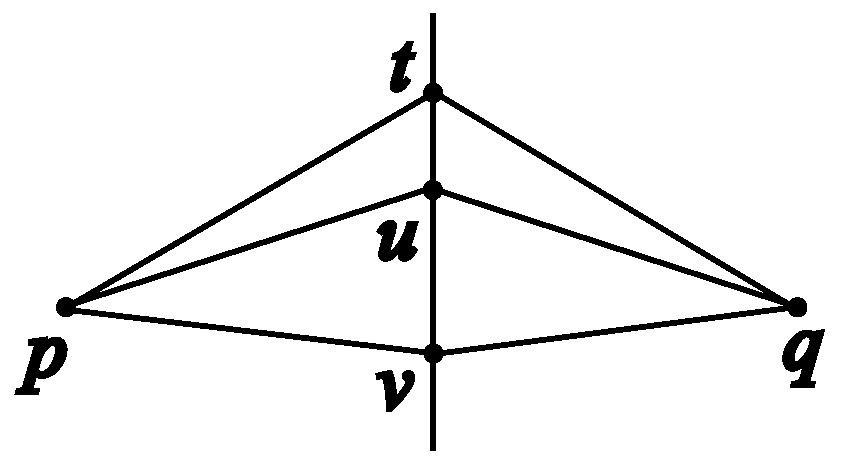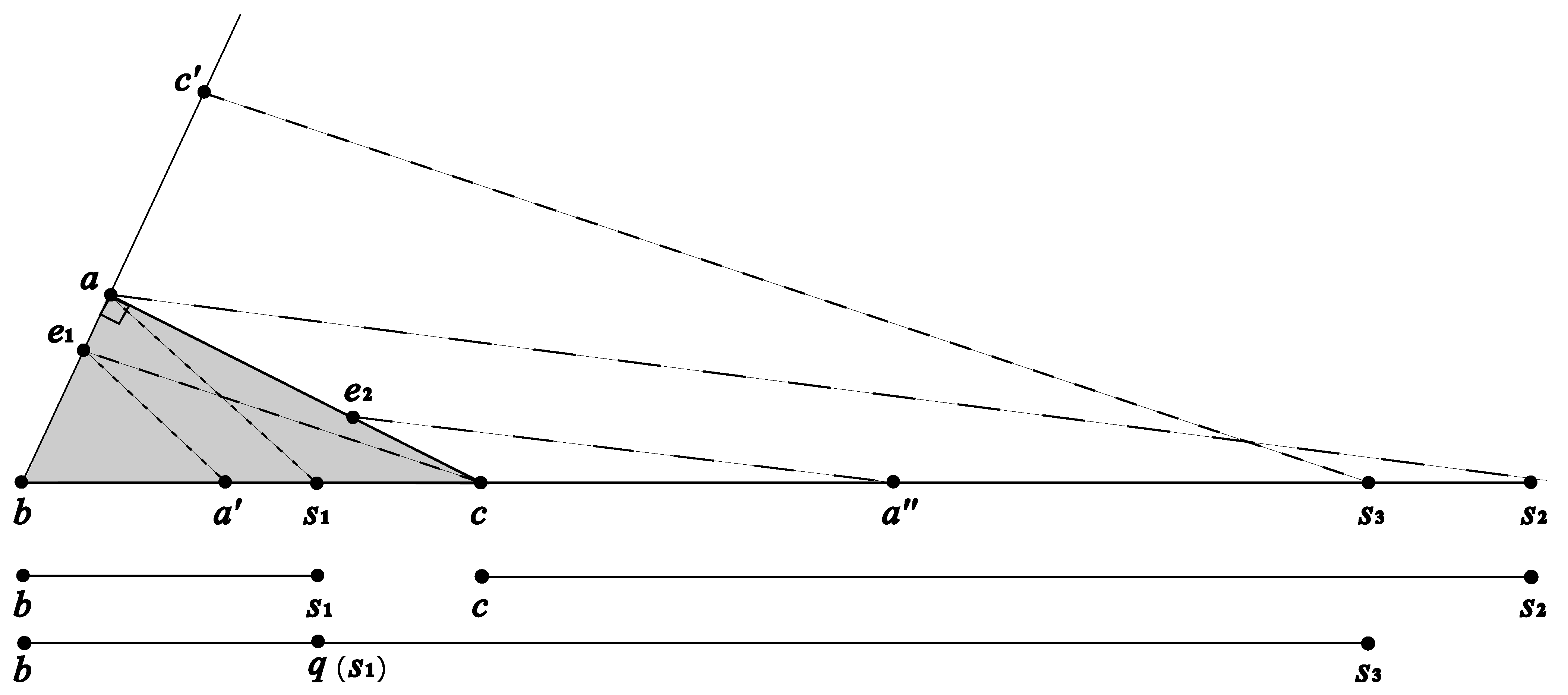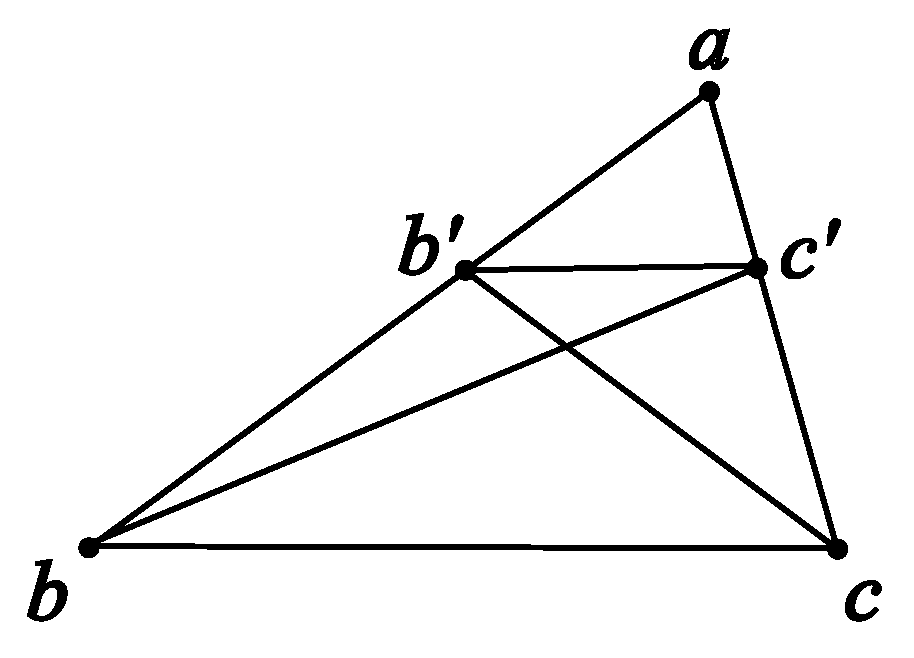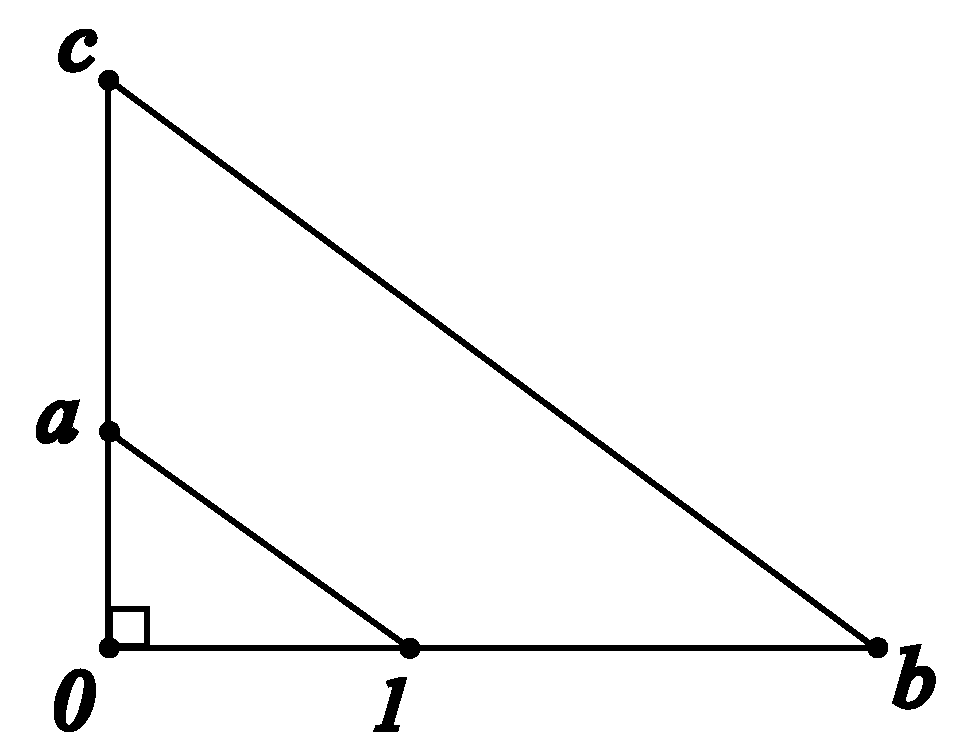1. Introduction
For more than two thousand years, Euclid’s
Elements [
1] stood as a standard of logical rigor. In the late nineteenth century, however, its shortcomings were exposed, prompting efforts to rebuild Euclidean geometry on firmer foundations. Two milestones were Hilbert’s
Grundlagen der Geometrie (1899) [
2] and the axiom system
developed by Tarski and his students [
3,
4,
5]. Hilbert used natural language, while Tarski introduced a first-order formal system “which can be formulated and established without the help of any set-theoretical devices” [
3] (p. 16).
Tarski’s
is formulated in a 1-sorted language: the only primitive objects are points. There are two primitive predicate symbols—a 3-place predicate symbol
B for betweenness, and a 4-place predicate symbol
D for segment congruence—with
meaning that
lies between
and
, and
meaning segment
(as a pair of end points) is congruent to segment
. This system has 11 axioms [
4,
5] (including one axiom schema), which are listed in
Appendix B. Tarski established that
is complete and decidable.
What part of the content in the Elements is not formalized in ? Notably, contains no notion of area—not even for polygons. In modern mathematics, area is a set function assigning a real number to every measurable set. Even when restricted to polygons, it still requires set-theoretic machinery, which Tarski deliberately avoided in .
The area function of polygons could be discussed in second-order logic, or in first-order logic with two sorts—one sort for points and the other for finite sets of points. The latter approach was discussed by Tarski in his 1959 paper [
3], with a sketch of a system
as a possible extension of
:
“The theory is obtained by supplement the logical base of with a small fragment of set theory. Specifically, we include in the symbolism of new variables assumed to range over arbitrary finite sets of points (or, what in this case amounts essentially to the same, over arbitrary finite sequences of points); we also include a new logical constant, the membership symbol ∈, to denote the membership relation between points and finite point sets. … In consequence the theory of considerably exceeds in means of expression and power. In we can formulate and study various notions which are traditionally discussed in textbooks of elementary geometry but which cannot be expressed in ; e.g., the notions of a polygon with arbitrarily many vertices, and of the circumference and the area of a circle.
As regards metamathematical problems which have been discussed and solved for in Theorems 1–4, three of them—the problems of representation, completeness, and finite axiomatizability—are still open when referred to . In particular, we do not know any simple characterization of all models of , nor, do we know whether any two such models are equivalent with respect to all sentences formulated in .”
Tarski did, however, resolve the decision problem for
in his Theorem 5 [
3]:
Theorem 5. The theory is undecidable, and so are all of its consistent extensions.
This follows from the fact that Peano arithmetic (PA) is (relatively) interpretable in
.
Note that in the same paper [
3], Tarski discussed several axiom systems, which he denoted
,
,
, and
, but with his primary focus on
. Each of these, in his own words, qualifies as a feasible interpretation of “elementary geometry”, and the problem of deciding which is the unique one “seems to be rather hopeless and deprived of broader interest”. For clarity, we retain Tarski’s original symbols when referring to these systems, since terms such as “
Tarski’s geometry” or “
elementary geometry” are ambiguous. Accordingly, claims like “Euclidean geometry is complete and decidable” or “elementary Euclidean geometry is complete and decidable” are inaccurate, as the systems
,
, and
provide immediate counterexamples.
Having considered the role of area, we now turn to the theory of proportion and similarity, which deals with quantitative relations such as segment lengths. This is the focus of the present paper, which we refer to as
Quantitative Euclidean Geometry. In informal treatments of geometry, it is usually taken for granted that every line segment has a length, which is a real number. The Pythagorean theorem provides a good example to illustrate this point. In its modern form, the theorem asserts
for a right triangle, where the bars denote numerical segment lengths. Ancient civilizations also knew this relation. The Egyptians reportedly used a knotted rope to form a 3-4-5 right triangle. In China, it appeared as the
gou-gu theorem (or Gougu theorem).
Gou and
gu refer to the shorter and longer legs of a right triangle respectively, since
gu means “thigh” in Classical Chinese. Euclid, however, expressed the theorem differently. In what follows, we examine the possible approaches to the Pythagorean theorem: what has been done, what can be done differently, and what cannot be done within first-order logic and without any appeal to set theory.
- (1)
The Area Approach by Euclid
The Pythagorean theorem in the
Elements is stated as follows [
1]:
Proposition I.47 In right-angled triangles the square on the side subtending the right angle is equal to the squares on the sides containing the right angle (
Figure 1).
For Euclid, the square on meant a geometric figure (a rectangle of equal sides), not the numerical product of a length and itself.
What, then, did he mean by saying that one square is equal to two other squares? Euclid did not provide an explicit definition, yet one can infer it from his proof:
Theorem. (Pythagoras-Euclid I.47) In a right triangle, the square on the hypotenuse can be dissected into n triangles, and the union of the two squares on the legs can also be dissected into n triangles with the resulting triangles congruent in pairs.
This formulation cannot be expressed in Tarski’s language , because does not contain a notion of area.
Hilbert developed a theory of area of polygons. His language is informal, and he uses the concept of set freely. Hilbert defines two predicates:
equidecomposable and
equicomplementable. Consider his definition of “equicomposable”:
Definition. Two polygons are called equidecomposable if they can be decomposed into a finite number of triangles that are congruent in pairs.
In Hilbert’s terms, what Euclid proved in his I.47 is actually: In a right triangle, the square on the hypotenuse is equidecomposable with the union of the two squares on the legs. However, “a finitely number” refers to a natural number, which is not in the language of
. The set of natural numbers (
) is not definable in
or in real closed fields (RCF). This helps explain why both
and RCF are complete and decidable, while the first-order Peano arithmetic of natural numbers is not.
While Hilbert’s theory of area is non-numerical, dealing with equidecomposable and equicomplementable relations only, we may have a theory of area in the numerical form (see Hartshorne [
6]). However, an area function that assigns a number to each polygon is a
set function, which cannot be part of a first-order language similar to
. Consider, for example, a theorem in Hartshorne [
6] (p. 206):
Theorem 23.2 In a Hilbert plane with (P), there is an area function , with values in the additive group of the field of segment arithmetic F, that satisfies and is uniquely determined by the following additional condition: For any triangle , whenever we choose one side to be the base and let it have length , and let h be the length of an altitude perpendicular to the base, then .
A formal first-order language prohibits quantification of functions (such as “there exists a function”), not to mention that the area function
is a higher-order function, meaning its domain is a set of sets.
Thus, the area approach is not viable for us: like Tarski, our aim is to avoid the use of set theory and remain within a first-order framework.
(As a side note, Hartshorne defines a Hilbert plane as one that satisfies Hilbert’s first three groups of axioms, and by (P) he means the axiom of parallels. Thus, this is simply a plane satisfying Hilbert’s first four groups of axioms, but without the axioms of continuity.)
- (2)
The “Segment Arithmetic” Approach by Hilbert and SST
Here and in what follows, we abbreviate Schwabhäuser, Szmielew, and Tarski [
5] as “SST”.
The Pythagorean theorem can also be formulated as the length relationship in Equation (
1), and proved using similar triangles. But how do Euclid, Hilbert, and Tarski treat the foundations of proportion and similarity?
The theory of similarity is based on the theorem of Thales, also known as the Fundamental Theorem of Proportion or the Fundamental Theorem of Similarity. This is Proposition VI.2 in the Elements:
Proposition VI.2 If a straight line be drawn parallel to one of the sides of a triangle, it will cut the sides of the triangle proportionally; and, if the sides of the triangle be cut proportionally, the line joining the points of section will be parallel to the remaining side of the triangle (
Figure 2).
Euclid used the theory of area to prove this Fundamental Theorem of Proportion. He argued that and have “equal-area” because they lie on the same base and are contained between the same parallels and . If we use to denote the area of , this can be written as . Consider and . Their bases and are on the same line, and they have the same altitude. Therefore, . Similarly, if we consider and , we can conclude . Therefore, . Note that we have used modern notation above. Euclid never used the word “area” explicitly.
Here, in this Fundamental Theorem of Proportion, the notion of area is not needed to state the theorem, but Euclid used the theory of area to prove it. Since Tarski’s lacks the notion of area, this proof cannot be carried over to .
If the segments and are commensurable, there exists an elementary proof of this theorem that does not rely on area. However, if and are incommensurable, a limiting process must be invoked; in effect, this limiting method is equivalent to an argument based on area.
Descartes and later Hilbert employed a solution by redefining the multiplication of segments. Consider a right triangle, as shown in
Figure 3. They choose the segment
as a unit. Suppose
and
are two points on these orthogonal lines. Draw the line through
and
, and then draw the line
parallel to
, intersecting
at
. The segment
is then
defined to be the product of
and
.
As Edwin Hewitt once remarked, “Old theorems never die; they turn into definitions”. Indeed, here the theorem of Thales is turned into the definition of the multiplication of segments. It is important to examine definitions carefully in mathematics. There are cases in mathematical treatments where definitions are made convoluted in order to make the theorems appear simple.
SST [
5] carried this further, recasting the segment arithmetic within
. They defined addition and multiplication directly on a coordinate line: the “geometric sum” and “geometric product” of two points yield another point on the same line, via projection constructions (see these definitions in
Section 6).
The Pythagorean theorem in the form of
appears as Theorem 15.8 in SST [
5], but this is a highly abbreviated formula with the definitions of geometric product and geometric sum. The complexity of this formula is hidden in the abbreviations (or definitions). When these abbreviations are fully expanded (see
Appendix D) using the definition of the geometric product, the theorem becomes a convoluted statement about constructed line segments. Each square is interpreted as a line segment. To Euclid, a segment multiplied by a segment yields a rectangular shape, while to Hilbert and SST, a segment multiplied by a segment yields another segment. So, in SST [
5], the meaning of
is that two line segments add up to a third segment (see
Appendix D).
In summary, we have examined two approaches to the Pythagorean theorem:
(i) Interpreting as (the area of) the shape of a square, as Euclid did. We have concluded that this is not a feasible direction for us to proceed.
(ii) Interpreting as (the equivalence class of) a line segment, constructed using parallel projections, which is indirect and cumbersome.
Besides these two, a third possible approach is the following:
- (3)
The Numerical Approach by Interpreting as the product of a number and itself
This is the direction we shall pursue in the present paper.
George Birkhoff [
7] proposed a system with four postulates, incorporating the notions of numerical measures of lengths and angles. However, it is not a formal system: it freely uses sets, real numbers, and
correspondences between sets. For example, he postulates the “
correspondence between the points on a line and the real numbers
x” to introduce the distance measure, and the “
correspondence between half-lines and the real numbers
a (mod
)” to introduce the angle measure.
In 1961, the School Mathematics Study Group (SMSG) developed an axiom system [
8] (see
Appendix C) intended for American high school geometry courses. Like Birkhoff’s approach, it employs real numbers to measure distances and angles but similarly lacks a formal language framework. While it designates point, line, and plane as undefined terms, this appears to refer only to primitive objects—the system does not explicitly declare undefined predicates or functions. A review of the SMSG axioms reveals that the system implicitly treats the distance function, angle function, area function, and volume function as undefined. Terms such as lie on, lie in, real number, set, contain, as well as correspondence, intersection, and union of sets, are used in the axioms but are not defined. The SMSG axiom list was made large and redundant, and the lack of independence of the axioms was intentional for pedagogical reasons.
The goal of the present paper is to incorporate numerical measures of distances and angles as function symbols into a first-order theory of Euclidean geometry, while avoiding set theory and retaining simplicity. Function symbols are admissible as primitives in first-order logic, since they are special cases of predicates.
We will show that the Axiom of Similarity plays a central role, effectively killing two birds with one stone: it provides the foundation for the theory of proportion and similarity, and it renders Euclid’s Parallel Postulate (EPP) as a theorem. The Axiom of Similarity can be viewed as a quantitative formulation of EPP. The Pythagorean theorem and other quantitative results from similarity theory can then be expressed directly in the first-order languages of and .
2. Theory —Quantitative Euclidean Geometry with a Single Geometric Primitive Notion—Distance Function
The system
is formulated in a first-order formal language
is a 2-sorted language: one sort for points, and the other for numbers. We shall use standard lowercase letters such as for numbers, and boldface lowercase letters such as for points.
The only geometric primitive notion is a 2-place function symbol d, with denoting the distance between two points and , which is a number.
The symbol = is overloaded for convenience: it denotes either the equality of two numbers or the identity of two points, depending on the context.
The symbols + and · are 2-place function symbols for numbers, denoting addition and multiplication. The symbol < is a 2-place predicate symbol for numbers, with denoting that x is less than y.
The symbols 0 and 1 are constant symbols for numbers.
| —The Theory of Plane Quantitative Euclidean Geometry with Distance Function in the Language |
We list the axioms of in the following.
Axioms RCF1 through RCF17 (for real closed fields, see
Appendix A)
RCF1 through RCF17 are the axioms for real closed fields, governing the predicate and function symbols for numbers. This is the first-order formulation of real numbers. As real closed fields are well studied, this is not the focus of the present paper.
Axioms D1 through D7 in the following are geometric axioms, in which all variables range over points, except for x in D4, which ranges over numbers.
Axiom D1. Axiom of Nonnegativeness
Axiom D2. Axiom of Identity
Axioms D1, D2, and D3 are the first three axioms of a metric space. A metric space also includes one more axiom—the triangle inequality. We do not need it as an axiom, as we will prove it in Theorem 8.
where
are points and
x is a number.
Figure 4.
Axiom of similarity.
Figure 4.
Axiom of similarity.
Informal explanation in plain English:
In
, suppose
cuts
and
at
and
respectively. If there is a number
k such that
and
, then
Axiom D5 is expressed in the form of multiplications rather than ratios, because we do not need to use an extra variable
k. In addition, an equation of products is more general than an equation of ratios, as we do not need to worry about division by zero.
Figure 5.
The dimension is at least 2.
Figure 5.
The dimension is at least 2.
Figure 6.
The dimension is at most 2.
Figure 6.
The dimension is at most 2.
This concludes the list of axioms for
. Note that Tarski’s
includes T11—axiom schema of continuity (see
Appendix B). We do not require it here, since RCF17 together with D4 implies T11.
Axiom D6 can be replaced by a weaker form:
This asserts that there exist three non-collinear points. When considered in isolation, D6 is strictly stronger than D6’, because D6 implies D6’ but not vice versa. However, in the presence of the rest of the axioms, they are equivalent, since D6’ also implies D6. In general, using an axiom that is too weak may leave certain true statements unprovable, while using one that is too strong may make it no longer independent of other axioms. D6 is independent in the system, because there exists a model of 1-dimensional geometry where D6 fails while all other axioms remain true. When standing alone, the negation of D6 does not imply that the dimension is one. However, the negation of D6 together with the rest of the axioms does imply that the dimension is one. We prefer D6 because it is simpler to state (using primitives only without definitions or abbreviations) and it generalizes more easily to higher dimensions (
Section 9). Basically, it is aligned with the affine-independence approach to dimension but stated in metric terms: there exists a nondegenerate 2-dimensional (regular) simplex, but there does not exist a nondegenerate 3-dimensional (regular) simplex. This can be easily generalized to
n-dimensional geometry: there exists a nondegenerate
n-dimensional (regular) simplex, but there does not exist a nondegenerate (
)-dimensional (regular) simplex.
Definition 1. (Between)
We shall use
as the abbreviation for the following:
Note that the betweenness defined here is non-strict, meaning holds if or . To compare, Tarski used non-strict betweenness, while Hilbert used strict betweenness.
Definition 2. (Collinear)
We shall use
as the abbreviation for the following:
Informally, means that the points are collinear.
Definition 3. (Triangle congruence by SSS)
We shall use
as the abbreviation for the following:
Informally,
is said to be congruent to
if all three pairs of corresponding sides are congruent.
Definition 4. (Triangle similarity by SSS)
We shall use
as the abbreviation for the following:
Informally, is said to be similar to if their three corresponding sides are in proportion. Clearly, triangle congruence is a special case of triangle similarity where .
Traditionally, two triangles are defined to be congruent if all their corresponding sides are congruent and all their corresponding angles are congruent. Two triangles are defined to be similar, if all their corresponding sides are in proportion and all their corresponding angles are congruent. However, it is easy to realize that the conditions on the angles are redundant in these definitions, because the side conditions alone imply that the corresponding angles are congruent—a fact that will be proved as theorems. Therefore, Definitions 3 and 4 differ from the traditional definitions of triangle congruence and triangle similarity found in most textbooks.
Definition 5. (Angle congruence by docking congruent triangles)
We shall use
as the abbreviation for the following:
Figure 7.
Congruence of angles.
Figure 7.
Congruence of angles.
Informally, angle is congruent to angle , if triangle can be “docked” into triangle at the vertex . By “docked”, we mean there exists a triangle such that .
Definition 6. (Addition of angles)
If
and
, we shall use
as the abbreviation for the following (this is the case when
and
are not supplementary):
Figure 8.
Addition of angles—non-supplementary case.
Figure 8.
Addition of angles—non-supplementary case.
Figure 9.
Addition of angles—supplementary case.
Figure 9.
Addition of angles—supplementary case.
Putting the two cases together, we define:
When the angles do not have a common vertex, we may also use
. By that, we mean there exist three other angles such that
We can also define the comparison of two angles, or the order of angles.
Definition 7. (Order of angles)
We shall use the abbreviation
for the following:
We also write to mean and
Note that we have defined the sum of two angles and the meaning of one angle is greater than another, but we have not assigned numerical values to angles, because that is not in the language of .
Definition 8. (Right angle)
We shall use
as the abbreviation for the following:
Theorem 1. (Triangle congruence SSS→AAA)
If two triangles are congruent, then their corresponding angles are congruent. Formally, Proof. The proof is trivial. The definition of the congruence of two triangles (Definition 3) means the triangles have three sides being congruent respectively. This simply fits the definition of the congruence of each of the three pairs of corresponding angles (Definition 5). □
The reason we include this theorem and the following seemingly simple theorems is that our Definition 3 of triangle congruence is different from most textbooks, and therefore we need to demonstrate how this definition works.
Theorem 2. (Triangle congruence criterion SAS)
If two triangles have the two sides congruent to two sides respectively, and the angle contained by the two sides congruent, then the two triangles are congruent. Formally,
Figure 11.
Triangle congruence criterion SAS.
Figure 11.
Triangle congruence criterion SAS.
Proof. By the definition of , there exist on the line and on the line such that .
We first discuss the two possible cases for point .
By the definition of , we have .
By the given condition , we must have .
Therefore, .
By Axiom D2, we know . Namely, point coincides with .
By the definition of , we have .
By the given condition , we must have .
Therefore, .
By Axiom D2, we know . Namely, point coincides with .
Therefore, coincides with . Because , we must have . □
Theorem 3. (Triangle congruence criterion ASA)
If two triangles have two angles congruent to two angles respectively, and the sides adjoining the congruent angles are congruent, then the two triangles are congruent. Formally,
Figure 12.
Triangle congruence criterion ASA.
Figure 12.
Triangle congruence criterion ASA.
Proof. By the definition of , there exist points and on line and respectively such that . Because , by a similar argument to that we used in the proof of Theorem 2, we can show that coincides with .
By the definition of , there exist points and on line and respectively such that . By a similar argument, we can show that coincides with .
Now that
coincides with
, and
coincides with
,
Figure 12 can be simplified as shown below.
Notice that by the definitions of and , we have and . Therefore, . That implies . Since and have the same side , we know must be collinear. Because , must coincide with . Furthermore, because is on both lines and , must coincide with . Namely, all three points coincide. Therefore, . □
Corollary 1. (Isosceles triangle)
In an isosceles triangle, the base angles are congruent to each other. Formally,
Figure 13.
Isosceles triangle.
Figure 13.
Isosceles triangle.
Proof. The triangle can be viewed as two triangles in different orientations. The first triangle has three sides , , in this order. The second triangle has three sides , , in this order. The three sides are congruent respectively. Therefore, . By Theorem 1, the corresponding angles are congruent. Namely, . □
Theorem 4. (Triangle similarity SSS→AAA)
If two triangles are similar, then their corresponding angles are congruent. Formally,
Figure 14.
Corresponding angles of similar triangles are congruent.
Figure 14.
Corresponding angles of similar triangles are congruent.
Proof. Let . By the given conditions, we have and . By Axiom D5, .
Find the point such that and . Similarly, find the point such that and . By Axiom D5, we have . Therefore, . This implies . Similarly we can prove . □
Theorem 5. (Triangle similarity criterion AA)
If two triangles have two pairs of corresponding angles congruent, then they are similar. Formally,
Figure 15.
Triangle similarity criterion AA.
Figure 15.
Triangle similarity criterion AA.
Proof. Let . On line , find the point such that and or . By Axiom D5, is similar to . By Theorem 4, . But it is given that . Therefore, . We say must coincide with , because both and are on the same line . Otherwise it would contradict the fact . Therefore, and , and it implies . □
Theorem 6. (Interior angle sum of a triangle)
In any triangle , the sum of its interior angles is a straight angle. Formally,
Figure 16.
The interior angle sum of a triangle is a straight angle.
Figure 16.
The interior angle sum of a triangle is a straight angle.
Proof. The given conditions imply that are the midpoints of , , and respectively. By Axiom D5, . This implies . In the same vein, we can show . Therefore, we have . As a consequence, is congruent to , and is congruent to .
By Axiom D5 again, we have , and . Therefore, we have . As a consequence, is congruent to . Because , , and form a straight angle, the interior angles of the triangle, , , and also “sum up” to a straight angle. □
As we can see in the following, using the distance function d, the Pythagorean theorem can be formally and directly stated in the language .
Theorem 7. (Pythagoras)
where is the abbreviation of .
Figure 17.
The Pythagorean theorem.
Figure 17.
The Pythagorean theorem.
Proof. From
, drop a perpendicular to
and let the foot be
, as shown in
Figure 17.
First, we want to prove that .
We use proof by contradiction. For the sake of contradiction, suppose that the foot is not between and . Without loss of generality, assume , as shown in the figure below.
Consider the triangle . The interior angles are , , and .
Note that is the sum of and , and is a right angle. is also a right angle.
In the sum of the interior angles of triangle , it includes two right angles ( and ), plus two extra angles ( and ). This contradicts Theorem 6, which asserts the sum of the interior angles of a triangle is equal to a straight angle. Therefore, we must have .
The triangle
is a right triangle.
and
have two pairs of congruent angles:
is congruent to
, and
is congruent to
(both are right angles). By Theorem 5,
Namely,
In the similar vein, we can prove that
Adding Equation (
2) to Equation (
3), we obtain
□
Figure 18.
Triangle inequality.
Figure 18.
Triangle inequality.
Proof. From , drop a perpendicular to and let the foot be . The triangle is a right triangle. The point may be between and , or not between and . We discuss three cases:
By Theorem 7, in the right triangle
, we have
Because
, we have
By Axiom D1, this implies
Similarly, if we consider the right triangle
, we obtain
Adding Equation (
4) to Equation (
5), we obtain
Because
,
. Therefore,
In the right triangle
, similar to Case (1), we have
Because
, we have
.
By Axiom D1,
, we have
. Therefore,
. This means the single side
is at least as long as
. When we add a nonnegative length
, we have
The same proof for Case (2) works for this case too, by a symmetry argument. □
Figure 19.
Axiom of five segments.
Figure 19.
Axiom of five segments.
Proof. Let , , , and .
From , drop a perpendicular to , and let the foot be . From , drop a perpendicular to , and let the foot be (see the figure below).
Let , , and .
First we want to show, because the two triangles are congruent, , their corresponding altitudes are also congruent, namely .
By the Pythagorean theorem,
Solving these equations, we obtain
In this expression, the altitude
h is uniquely determined by the side lengths
of
. We therefore conclude that the congruent triangle
must have the same altitude
h.
Now consider the right triangle
. By the Pythagorean theorem,
Note that
is uniquely determined by
, the lengths of the four segments that have their corresponding congruent counterparts in the other configuration with primed points. Therefore, we must have
.
Case (2): If is not between and , the proof is just similar, and we will omit it. The only difference is, the relationship should be replaced by or . □
Figure 20.
Axiom of Pasch, inner form.
Figure 20.
Axiom of Pasch, inner form.
Proof. Let , , and .
From , drop a perpendicular to . Let the foot be , and .
First, we construct a point in two steps.
Step 1: On line
, find the point
between
and
such that
, where
It is easy to see . By Axiom D4, for any number , such a point exists.
Step 2: From
, draw
perpendicular to
on the side of
such that
, where
It is easy to see . By Axiom D4, for any number , such a point exists.
We claim that is a point that satisfies and .
Verification of :
By repeated applications of the Pythagorean theorem to the right triangles
,
,
, and
, we obtain
Therefore, .
Verification of :
By repeated applications of the Pythagorean theorem to the right triangles
,
,
, and
, we obtain
Therefore, .
The proof is similar to Case (1), and we will omit it. □
4. Theory —A Conservative Extension
of with Angle Function
The language of has a single geometric primitive function d, the distance function, apart from the operations for numbers. We can extend theory further to a theory to include the angle function a, which denotes the numerical measure of an angle.
The language of
is
where
a is a 3-place function, with
being the number to represent the measure of angle
formed by points
, and
, with
as the vertex.
The system
must satisfy axioms RCF1 through RCF17 (
Appendix A), Axioms D1 through D7, plus A1 through A4, which shall be listed in this section.
First, we explain what we mean by being a conservative extension of .
Let be a theory in the language , a theory in the language , and .
is called an extension of if .
is called a conservative extension of
if
is an extension of
, and for each
A in
,
if and only if
, meaning the only new theorems in
are those that use symbols in
that are not in
(see Epstein [
9]).
In the following, we list the axioms of .
| —The Theory of Plane Quantitative Euclidean Geometry with Distance and Angle Functions in the Language |
See Definition 5 in
Section 2 for the abbreviation
.
Informal explanation in plain English: Congruent angles have equal angle measures and vice versa.
Figure 22.
Addition of angles.
Figure 22.
Addition of angles.
See Definition 6 in
Section 2 for the abbreviation
.
where 180 is the abbreviation for
(one hundred eighty times), and 1 is the multiplicative identity, which is a constant symbol in the system of RCF (
Appendix A).
By Axioms A3 and A4, it is easy to see that the maximum value of any angle measure is 180.
Theorem 11. Informally, this means the angles are undirected. As we can see, there is no need to list this as an axiom. The symmetry of the angle measure is a consequence of the symmetry of distance, .
Proof. This is straightforward, because by definition, the angles and are congruent. □
Lemma 1.
Proof. By Axiom A3, if
, then
. Now consider a special case where
,
, and
. We have
Therefore,
. □
Theorem 12. Informally, if and are on the same “ray”, then the measure of is zero. This shows there is no need to list this as an axiom.
Proof. Because , by definition, . By Axiom A2 and Lemma 1, . □
Next, we shall prove the theorem of vertical angles in both and separately.
Theorem 13. (Vertical angles)
Figure 23.
Verticle angles.
Figure 23.
Verticle angles.
Proof. (Proof in ) Because , and are supplementary angles. Therefore, . Similarly, and are supplementary angles. We have . Therefore, we have . This is the same as . By Axiom A2, we have . □
This is Proposition I.15 in Euclid’s Elements. Euclid’s proof is basically the same as above, except that Euclid did not make the measure of an angle explicit, and he simply cited his Common Notion 3: “If equals be subtracted from equals, the remainders are equal”. Note that we have defined the addition () of two adjacent angles to be a third angle (Definition 6), but there is still a difference between an angle and the measure (as a number) of the angle.
As we have commented, is a conservative extension of . The vocabulary of Theorem 13 does not involve the angle function a. It should be able to be proved in . An alternative proof strictly within the theory is shown in the following.
Proof. (Proof within ) By Theorem 12, the points on the same “ray” make the same (congruent) angle. Instead of reasoning with points , we mark points such that , , , and all have the same length. All we have to show is that . To show this, it suffices to show that , because that would guarantee .
First we observe that is an isosceles triangle. Therefore, by Corollary 1, we have .
Consider and . They have a common side . The sides and are congruent. The contained angles and are also congruent. Therefore, by Theorem 2 (SAS). We then have .
Finally we have . Hence, . This is the same as .
□
